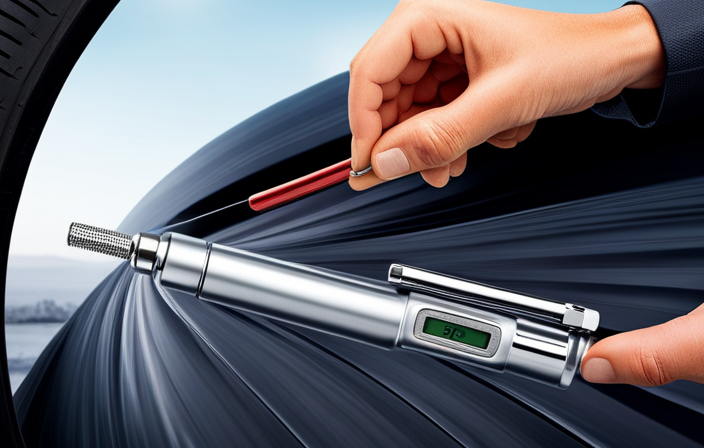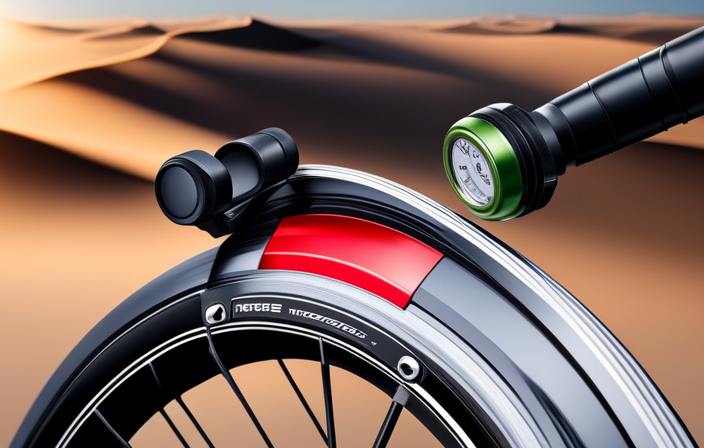Have you ever experienced difficulty in repairing a broken bicycle chain? Do not worry anymore! This article will walk you through the detailed process of disassembling a bicycle chain.
With the right tools and a little patience, you’ll be back on the road in no time. So, grab your toolbox and prepare to dive into the intricacies of chain disassembly.
Trust me, it’s easier than it sounds, and the satisfaction of fixing it yourself is worth it. Let’s get started!
Key Takeaways
- Prepare necessary tools and workspace for chain removal
- Remove the rear wheel carefully to avoid damage
- Locate and use the master link for chain disassembly
- Use a chain breaker tool for precise and safe separation of the chain
Gather the Necessary Tools
You’ll need a few tools to take the bicycle chain apart. When it comes to replacing a bicycle chain or fixing a broken chain link, having the right tools is crucial.
First, you’ll need a chain tool, which is a small handheld device specifically designed for removing and installing chain pins. This tool allows you to push the pin out of the chain and remove the link.
Additionally, you’ll need a pair of chain pliers to hold the chain and make it easier to manipulate.
Lastly, having a compatible quick link or a master link is essential for reassembling the chain after you’ve taken it apart. With these tools, you’ll be well-equipped to tackle the task at hand.
Now, let’s move on to preparing your workspace.
Prepare Your Workspace
Before getting started, make sure to gather all the necessary tools and find a suitable workspace. Workspace organization is crucial to ensure efficiency and safety during the process. Clear any clutter and make sure you have enough space to work comfortably.
Safety precautions are essential when working with a bicycle chain. Wear protective gloves and safety goggles to protect your hands and eyes from any potential injuries. It is also advisable to have a clean cloth or towel nearby to wipe off any grease or dirt. Additionally, keep a small container or tray to hold any small parts you may need to remove.
With your workspace organized and safety measures in place, you are now ready to move on to the next step of removing the rear wheel.
Remove the Rear Wheel
To remove the rear wheel, make sure you have all the necessary tools and find a suitable workspace.
Start by shifting the chain onto the smallest chainring and the smallest rear cog. This will relieve tension on the chain and make it easier to remove the wheel.
Use a wrench or quick-release lever to loosen the axle nuts or release the quick-release skewer. Once the axle nuts or quick-release skewer are loose, slide the rear wheel out of the dropouts. Be careful not to damage the derailleur or the chain in the process.
Common mistakes to avoid when removing the rear wheel include forgetting to shift into the smallest gears, not loosening the axle nuts or quick-release skewer enough, and forcing the wheel out of the dropouts.
With the rear wheel removed, you can now move on to locating the master link.
Locate the Master Link
Next, locate the master link on the bicycle chain. This link is designed to be easily removable, allowing for quick and convenient chain maintenance. Here are the steps to locate the master link:
-
Examine the chain: Look for a link that appears different from the others, usually with a clip or pin holding it together.
-
Check for markings: Some master links may have manufacturer markings or a different color to make them easier to identify.
-
Use a flashlight: Shine a light on the chain to get a clearer view and make it easier to locate the master link.
-
Consult the manual: If you’re unsure, refer to the bicycle’s manual or contact the manufacturer for specific instructions on locating the master link.
Using a master link in bicycle chains offers several benefits, such as easy chain removal for cleaning or replacement. However, locating the master link can sometimes be challenging due to its small size or hidden position. In such cases, patience and thorough inspection are key.
Once the master link is located, we can proceed to the next section on how to use a chain breaker tool.
Use a Chain Breaker Tool
Once you’ve located the master link, you can use a chain breaker tool to make any necessary adjustments or repairs. A chain breaker tool is a specialized tool designed specifically for removing and installing bicycle chains. It allows for precise control and ensures that the chain is properly separated without causing any damage to the links.
To use a chain breaker tool, follow these steps:
- Position the chain in the tool: Place the chain breaker tool onto the chain, aligning the pin with the chain pin you want to remove.
- Turn the handle: Use the handle of the tool to slowly push the pin out of the chain. Continue turning until the pin is fully removed.
- Remove the chain: Once the pin is out, you can easily separate the chain using your hands.
Although a chain breaker tool is the recommended method for removing a chain, there are alternative methods such as using a hammer and a punch. However, these methods are less precise and can potentially damage the chain or surrounding components.
Next, let’s discuss how to position the chain breaker tool for optimal results.
Position the Chain Breaker Tool
First, make sure you align the pin of the chain breaker tool with the pin on the chain you want to remove. This is a crucial step in the chain breaker technique to ensure proper chain alignment.
The chain breaker tool should be positioned so that the pin is directly aligned with the pin on the chain. This will allow the tool to apply even pressure and prevent any damage to the chain or the tool itself. Double-check the alignment before proceeding to the next step.
Once the tool is in the correct position, you can proceed to break the chain. By following this precise technique and ensuring proper chain alignment, you can safely and effectively take apart the bicycle chain.
Break the Chain
To break the chain, align the pin of the chain breaker tool with the pin on the chain and position the tool correctly. Make sure the chain is securely held in the tool’s jaws before proceeding.
Apply pressure to the handle of the tool, pushing the pin against the chain link’s pin. Slowly rotate the handle clockwise until the pin begins to push through the link. Continue turning the handle until the pin is fully pushed out of the link.
Once the pin is removed, carefully separate the broken link from the chain. Repairing bicycle chains is essential to prevent common chain problems such as skipping gears or chain slippage.
Now that the chain is broken, we can move on to the next step of removing the broken link.
Remove the Broken Link
Next, use pliers to carefully remove the broken link from the chain. Repairing a chain rather than replacing it can save time and money, especially if the chain is still in good condition overall. Common causes of chain breakage include wear and tear, improper maintenance, and excessive force applied to the chain. To remove the broken link, follow these steps:
- Position the chain with the broken link at the edge of a flat, sturdy surface.
- Use pliers to grip the link on either side of the break.
- Apply gentle pressure to push the link pins outwards until they separate.
- Remove the broken link from the chain.
By repairing the chain, you can extend its lifespan and ensure smooth and efficient cycling. Now, let’s move on to the next step and learn how to detach the chain from the front gears.
Detach the Chain from the Front Gears
To remove the broken link from the bicycle chain, I used a chain tool and carefully pushed out the pin holding the link together.
Now, to detach the chain from the front gears, I will need a 5mm Allen wrench. First, I locate the bolts that secure the chainrings to the crankset. Using the Allen wrench, I loosen and remove these bolts. It is important to be cautious during this step to avoid stripping the bolts or damaging the crankset.
Once the bolts are removed, I gently slide the chain off the front gears, making sure not to force it or twist it. Common mistakes include not fully loosening the bolts or not supporting the chain while removing it, which can result in damage.
Now, let’s move on to the next section about cleaning the chain.
Transition: With the chain detached from the front gears, it’s time to move on to cleaning it thoroughly.
Clean the Chain
Now, you can start cleaning the chain to remove any dirt and grime that may have built up. Cleaning the chain is an essential step in maintaining the overall performance of your bicycle.
There are several cleaning techniques you can use, such as using a chain cleaning tool or a brush and degreaser. Make sure to thoroughly clean each link of the chain to ensure all the debris is removed.
A clean chain not only improves shifting and pedaling efficiency but also extends the lifespan of the chain and drivetrain components. It reduces friction, which helps prevent wear and tear.
Once the chain is clean, you can move on to the next step of lubricating it, ensuring smooth and quiet operation.
Lubricate the Chain
To properly maintain your bike’s chain, you should regularly lubricate it to ensure smooth and quiet operation. Regular chain lubrication is crucial for the overall performance and longevity of your bike.
The main importance of regular chain lubrication is to reduce friction and wear between the chain links and the gears. This helps to prevent premature chain stretch and extends the lifespan of both the chain and the gears.
There are different types of chain lubricants available, such as dry lube, wet lube, and ceramic lube. Dry lube is best suited for dry conditions, while wet lube is ideal for wet and muddy conditions. Ceramic lube provides enhanced durability and reduced friction. Choosing the right chain lubricant depends on the riding conditions and personal preference.
It is essential to apply the lubricant evenly and wipe off any excess to prevent dirt buildup. Now, let’s move on to the next step of reinstalling the chain onto the front gears.
Reinstall the Chain onto the Front Gears
After lubricating the chain, it is time to reinstall it onto the front gears. To ensure smooth shifting and optimal performance, it is important to realign the front derailleur and adjust the chain tension properly.
Here are the steps to follow:
- Begin by placing the chain onto the smallest chainring.
- Next, carefully guide the chain onto the teeth of the front gears.
- Check the alignment of the front derailleur and make any necessary adjustments to ensure the chain sits properly on the gears.
- Once the chain is in place, test the shifting to ensure it moves smoothly between gears.
- Finally, check the chain tension and make any adjustments needed to ensure it is neither too loose nor too tight.
By following these steps, you will successfully reinstall the chain onto the front gears. Now, we can move on to the next step of reattaching the rear wheel.
Reattach the Rear Wheel
First, make sure the rear wheel is properly aligned with the frame.
To reattach the rear wheel, start by sliding the axle into the dropouts on the frame. Align the chain onto the rear gears and make sure it is properly seated on the teeth. Then, tighten the nuts or quick release skewer to secure the wheel in place.
Next, check the alignment of the chain. It should run smoothly on the rear gears without any skipping or rubbing. If needed, adjust the tension using the derailleur or the tensioner on the frame.
Once the chain is aligned properly, you can proceed to the next step of testing the chain’s functionality.
Test the Chain
Now, you can check if the chain is working properly by pedaling the bike and observing if it moves smoothly and without any noticeable issues.
To test the chain, there are a few methods you can use. First, inspect the chain visually to ensure it is properly aligned and tensioned. Look for any signs of damage or wear, such as rust or bent links.
Next, listen for any unusual noises while pedaling, as this could indicate a problem with the chain.
Finally, you can also manually move the chain with your hand to feel for any stiffness or resistance. If the chain passes these tests and moves freely without any issues, then it is in good working condition.
Transitioning into the next section about final tips and maintenance recommendations, it is important to keep the chain clean and lubricated to prolong its lifespan and ensure optimal performance.
Final Tips and Maintenance Recommendations
After testing the chain for any potential issues, it’s time to move on to the final tips and maintenance recommendations. Proper maintenance is crucial to keep your bicycle chain in optimal condition for smooth and efficient rides. Here are some maintenance tips to keep in mind:
- Regularly clean and lubricate the chain to prevent rust and ensure smooth operation.
- Check for any signs of wear, such as stretched links or damaged rollers, and replace the chain if necessary.
- Keep an eye out for common chain issues, like skipping gears or noisy operation, as these may indicate a need for adjustment or replacement.
To ensure the longevity of your bicycle chain, it’s essential to follow these maintenance recommendations and promptly address any issues that arise. Taking care of your chain will result in a smoother and more enjoyable riding experience.
Frequently Asked Questions
How do I know if my bike chain needs to be taken apart?
To know if my bike chain needs to be taken apart, I inspect it for signs of wear and tear such as rust, stretched links, or excessive noise. Properly cleaning and maintaining the chain regularly can help prevent these issues.
Can I use any type of lubricant on my bike chain?
I can use various types of lubricants on my bike chain, such as dry, wet, or wax-based lubricants. However, using the wrong lubricant can cause potential damage, such as attracting dirt and debris or wearing out the chain prematurely.
Is it necessary to remove the rear wheel in order to take apart the chain?
Removing a bike chain without removing the rear wheel? Absolutely not! It’s like trying to climb Mount Everest without oxygen. However, there are alternative methods like using a chain breaker tool to take the chain apart.
How often should I clean and lubricate my bike chain?
I clean and lubricate my bike chain regularly to maintain its performance and longevity. Regular chain maintenance, including cleaning and lubrication, helps prevent rust, wear, and noise, ensuring smooth and efficient operation of the bike.
What are some common mistakes to avoid when using a chain breaker tool?
When using a chain breaker tool, common mistakes include applying too much force, misaligning the tool with the chain pin, and not fully inserting the pin into the chain link. These errors can damage the chain or the tool.
Conclusion
In conclusion, dismantling a bicycle chain may seem daunting, but it can be accomplished smoothly with the right tools and patience. By following the steps outlined above, you can confidently disassemble and reassemble your chain, ensuring a smooth ride.
Remember, practice makes perfect, so don’t be discouraged if it takes a few tries to get it right. As the saying goes, ‘A well-oiled chain is the key to a smooth ride.’
So, take the time to maintain your chain regularly for optimal performance.









